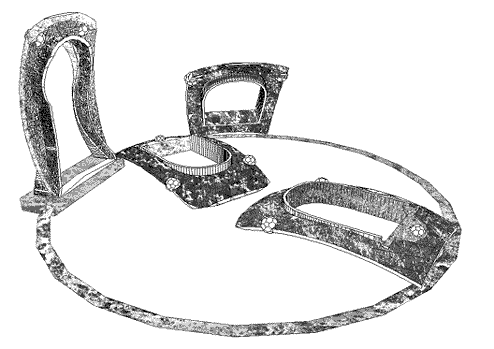
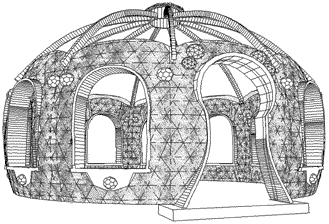
Tilt up construction allows using the ground as a form for casting cement . The example above explores the simplicity in "tilting up" a very small dome building.
The content on this website, http://harmoniouspalette.com, is placed in the public domain only as a free exchange of ideas and as a "hard studied wish to serve life". The author assumes no responsibility for the improper use of the concepts in these web pages, as all relevant laws of life and local codes should be verified and observed before any building or experimentation proceeds. discussion is welcome, please write. Bo Atkinson
A different building method concept is offered for comparison named "ringforcement. Here is a page describing Ringforcement :A synergy of ferocement, concrete, masonry and curved construction.
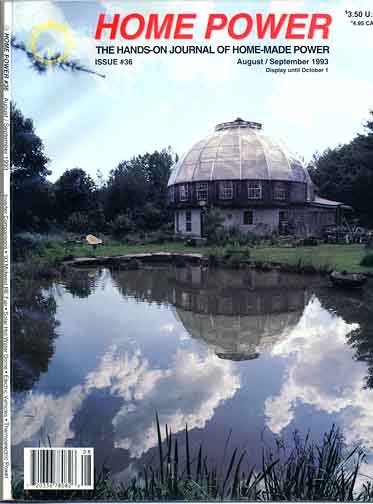
News from summer 2003-- http://www.kalwall.com/nano1.htm the worlds first commercial arogel panel, (a bit expensive yet).
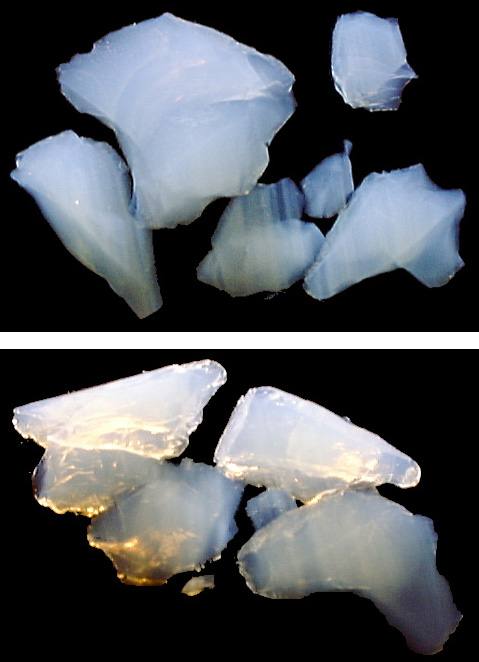
Two photos of silica gel fragments. The first is taken from above, the second at an angle with camera nearly facing the light source, (sun). I obtained these from The Lawrence Livermore Lab many years ago when they were government funded to promote the commercial potentials of the material. The packet which I received contained about an inch thick pile of technical documents and a nice little brick of silica gel. Over the years, the brick chipped away and i confess to my curiosity in testing its breaking strength. My sample was weak.
Every one I showed this sample to loved the hint of iridescence. This aesthetically pleasing quality may be one of the eventual selling points of this material. It seems looking back from today, promoters might have well spent some money showing off this aspect in magazines articles of many persuasions to stir up a broad based interest. Within reason it is conceivable that translucent buildings could both control temperature comfort and provide lighting reminiscent to ice caves! This may well transpire eventually, (noting the surprises with technology). CAD animated fly throughs of translucent buildings, using radiosity rendering, might just stimulate interest. (Eventually examples will appear here, or linked to this URL).
Silica gel is a stable "foam" of silicon molecules. The fine matrix of silicon molecules traps countless air spaces which make the material light weight and a good insulator. No doubt differing products could evolve beyond the original forms. Here is a very nice descriptive page from the Berkley Labs "Aerogel Research at LBL: From the Lab to the Marketplace" Getting the strength up to styrofoam levels might reduce some of its desirable qualities, but I am optimistic about this technology in the future, despite any thing else. Another URL atNasa on aerogels, click here.
I seem to remember some URLs out there describing silica gel technology, (casually found through search engines). Some company was selling silica gel as a special applications, high performance insulation. But it would take a massive industrial effort to make the material viable in the housing market, (as translucent roofing insulation).
The content on this website, http://harmoniouspalette.com, is placed in the public domain only as a free exchange of ideas and as a "hard studied wish to serve life". The author assumes no responsibility for the improper use of the concepts in these web pages, as all relevant laws of life and local codes should be verified and observed before any building or experimentation proceeds. discussion is welcome, please write. Bo Atkinson
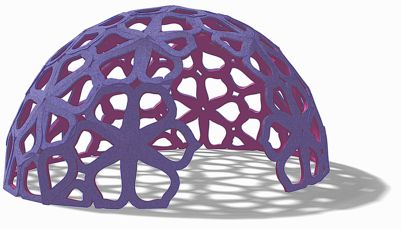
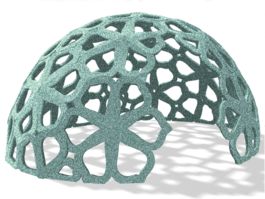
![]()